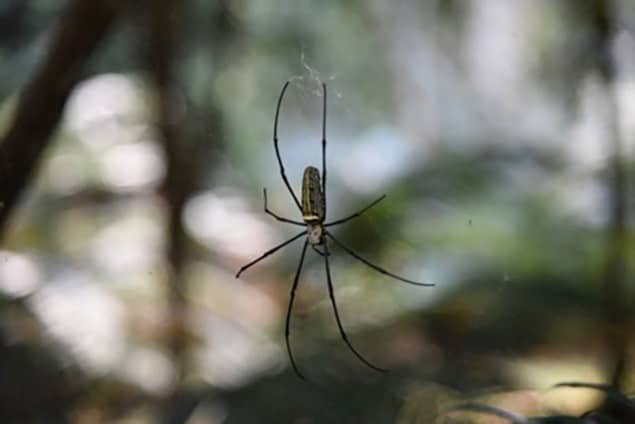
Spiders don’t spin when hanging from their webs because their silk dissipates energy by partially deforming when twisted. This is the conclusion of Dabiao Liu from Queen Mary University of London in the UK and colleagues, who have investigated the unusual ability with the hope it can be mimicked in synthetic fibres.
Spiders produce various types of silk, each with different properties for specific purposes. For the outer rim and spokes of their webs, they use dragline silk, which has incredible strength comparable to high-grade steel. Spiders also use this silk to lower themselves from heights. But, rather unusually, spiders do not spin uncontrollably on their threads as they descend. “Spider silk is very different from other, more conventional materials,” says Liu. “We find that the dragline from the web hardly twists, so we want to know why.”
The team tested the silk of two species of golden silk orb weavers using a torsion pendulum experiment. They suspended washers from dragline silk in an isolated environment, thereby removing any external disturbances. Using a turntable, they twisted the silk and recorded the behaviour with a high-speed camera.
Liu and colleagues discovered the silk deforms slightly when twisted, while carbon-fibre and metal wires do not, and therefore causes the washers to spin. This process dissipates more than 75% of the potential energy, rapidly slowing oscillations. When twisting stops, the silk partially snaps back.
The researchers suggest the unusual property is due to the silk’s structure – a core of multiple fibrils surrounded by a “skin”. The fibrils are made of amino acids, some of which are organized in sheets and others in unstructured looping chains. Liu and team believe twisting causes the sheets to stretch, and warps the hydrogen bonds linking the chains. While the sheets return to their original shape when twisting stops, the chains remain partially deformed.
This unique ability to glide gracefully from heights helps spiders avoid startling prey or attracting predators. If scientists can harness the property in synthetic fibres, they could have many applications, such as violin strings, helicopter rescue ladders and parachute cords. Liu and team’s study is presented in Applied Physical Letters.



